Table of Contents
ToggleSafe Investments in India with High Returns – Where to Put Your Money in 2025
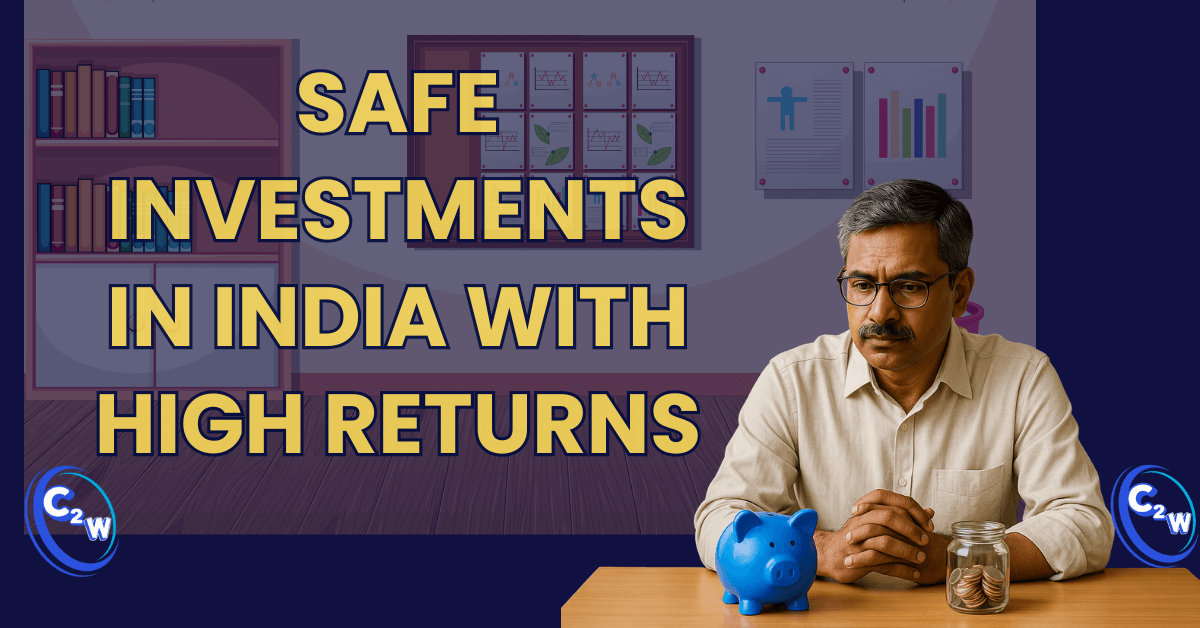
In the staffroom, Mr. Shiv Kumar, a science teacher, leans closer to his colleague and whispers:
“Sir, paisa toh hai thoda bachta… par dar lagta hai risky cheezon mein daalne se. Batao koi safe investment jo return bhi accha de.”
(“Sir, I do manage to save a little money… but I’m afraid of putting it into risky things. Tell me a safe investment that also gives good returns.”)
This isn’t just Shiv Kumar’s dilemma—it’s the heartbeat of most Indian teachers and middle-class families in 2025. For us, safety comes first, growth is an afterthought. Fixed deposits, recurring deposits, and provident funds feel secure, but do they truly protect us from rising inflation and the ever-increasing costs of children’s education?
The encouraging truth is: safe investments in India with high returns do exist. They may not be “get-rich-quick” tricks, but they strike the balance every teacher and family needs—capital protection plus growth that beats inflation. The real challenge is learning to separate genuinely safe options (like PPF, EPF, Sukanya Yojana, RBI Bonds) from traps often mis-sold as “safe” (such as bundled insurance plans or chit funds).
Before we dive in, if you’re still building your first money cushion, start here: Emergency Fund for Teachers – The Sandook System. It’s the foundation of every safe investment journey.
In this article, we’ll explore how even the most cautious investors—teachers like Shiv Kumar’s or principals planning retirement—can build wealth in 2025 with investments that are secure, inflation-beating, and stress-free.
Understanding Safe Investments in India with High Returns
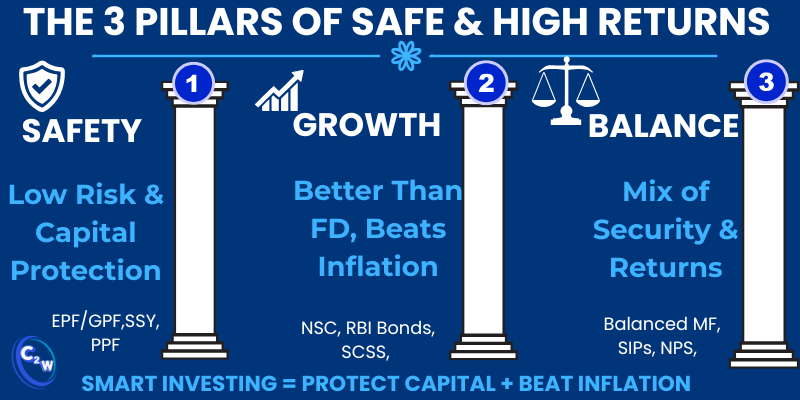
“Safe” = Low Risk & Capital Protection
When we talk about safe investments in India with high returns, the first pillar is safety. A safe investment means your principal is protected, and the risk of loss is minimal. Most of these are backed by the government or come with guarantees. For example, small savings schemes such as PPF or Sukanya Samriddhi carry a sovereign guarantee—your interest and principal are 100% secure. Even if markets fluctuate, your hard-earned savings stay protected.
For teachers who want a step-by-step foundation, start with this guide: Safe Investment Options for Teachers Beyond GPF.
“High Returns” = Better Than FD, Beats Inflation
The second pillar is growth. “High returns” doesn’t mean doubling your money overnight—it simply means better than the ordinary. The real benchmark is beating both fixed deposit (FD) rates and inflation. If FD rates hover around ~5% while inflation is ~6%, you’re actually losing value. That’s why safe investments in India with high returns aim for 7–8% or more annually, so your savings grow in real terms and protect your purchasing power.
To understand why time and compounding matter so much, check this Chalk2Wealth explainer: Can Compound Interest Really Make You Rich in 2025?.
Balancing Both = Smart Investing
The real art lies in balancing both pillars. True safe investments in India with high returns combine capital protection with steady growth. This often means keeping a foundation in ultra-safe products (for security) while allocating a portion to instruments that deliver slightly higher returns. By making informed choices, you can build a portfolio that preserves your capital, beats inflation, and steadily builds wealth over time.
See how this works in practice in our case study: Diversified Investment Portfolio – 6 Smart Lessons for Tutors.
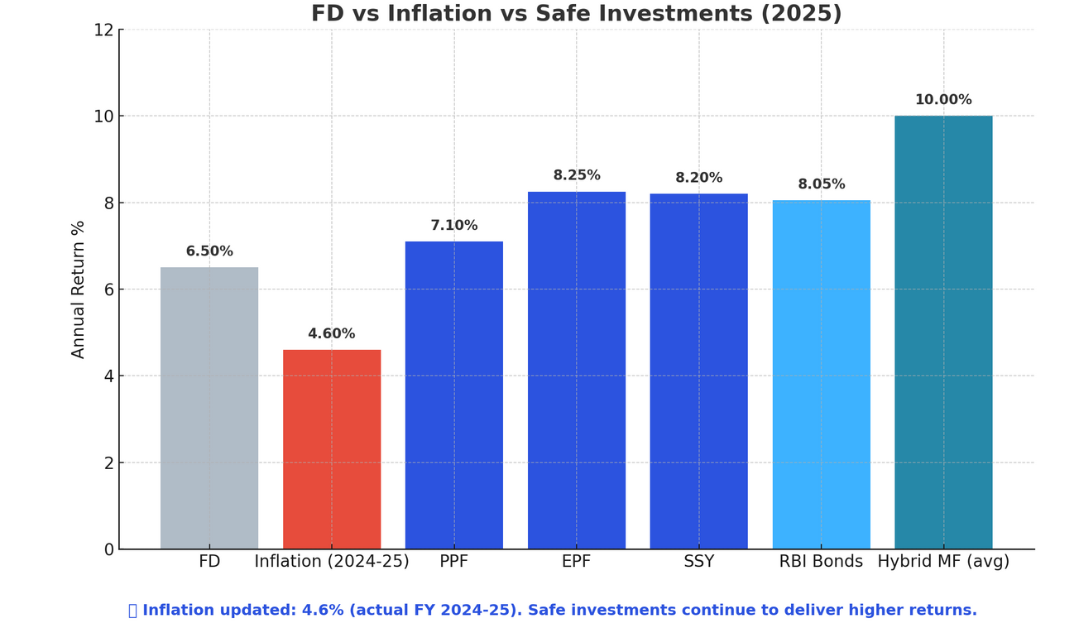
Inflation: 4.6% (actual FY 2024–25). FD rates shown (6.5%) are illustrative; actual bank FDs vary ~6.25–7.25% depending on tenure and bank
Best Safe Investments in India with High Returns
Safe investments in India with high returns don’t mean taking unnecessary risks. They are about stability, protection of capital, and growth that beats inflation. For teachers and other cautious savers, the Indian market in 2025 offers multiple government-backed and institution-backed choices that deliver peace of mind along with decent returns. Here are the most reliable options:
Public Provident Fund (PPF) – ~7.1% Annual Interest (Tax-Free)
PPF is one of the most trusted safe investments in India with high returns. Backed by the government with a 15-year lock-in, it currently pays 7.1% per annum. The interest is tax-free, making it excellent for retirement planning for teachers. Partial withdrawals are allowed after 5 years, ensuring flexibility with security.
Employees’ / General Provident Fund (EPF / GPF) – ~7–8% Annual Interest
For salaried employees, EPF and GPF remain rock-solid safe investments in India with high returns. EPF is offering 8.25% interest for FY 2024–25, while GPF for government teachers is ~7.1%. Both are backed by the government and are ideal for long-term corpus building, with tax benefits on withdrawal under prescribed rules. But remember, teachers have investment options beyond GPF that can provide better diversification and growth.
National Savings Certificate (NSC) – 7.7% Annual Interest (5-Year Lock-In)
The NSC, available via post offices, provides 7.7% returns with sovereign security. With a 5-year lock-in, it’s a medium-term safe investment in India with high returns, plus you can claim Section 80C tax deductions.
Sukanya Samriddhi Yojana (SSY) – 8.2% Annual Interest (Girl Child Scheme)
SSY is among the best safe investments in India with high returns, especially for parents of daughters under 10. Offering 8.2% tax-free interest, it’s a government-guaranteed scheme designed to fund education and marriage goals, with partial withdrawals allowed for higher studies.
RBI Floating Rate Bonds (2020) – ~8.05% Annual Interest (7-Year Bond)
Issued by the Reserve Bank of India, these bonds guarantee 8.05% interest. They reset every 6 months, pegged at 0.35% above the NSC rate. As government bonds, they carry zero credit risk, making them one of the most dependable safe investments in India with high returns for lump-sum investors.
Debt Mutual Funds / Liquid Funds – ~6–8% Annual Returns
For teachers looking for liquidity with reasonable growth, high-quality debt funds are relatively safe investments in India with high returns. By investing in bonds and government securities, they typically yield 6–8%. Short-duration funds reduce interest rate risk, though taxation must be considered. To understand the basics, start with this guide: What are mutual funds? 5 powerful reasons to start.
Balanced / Hybrid Mutual Funds (via SIP) – ~9–11% Potential Returns
Hybrid funds blend equity and debt, offering a balanced path for conservative investors. SIPs in hybrid funds can deliver 9–11% annualized returns over the long term. While not risk-free, they qualify as moderate-risk safe investments in India with high returns, suitable for teachers willing to accept slight market exposure for higher growth. Learn how to mix safety with returns here: Diversified Investment Portfolio – 6 Smart Lessons for Tutors.
Other Notable Mentions
- Fixed Deposits (FDs): 6–7.5% (safe, but taxable and often below inflation).
- Senior Citizens’ Saving Scheme (SCSS): 8.2% with quarterly payouts. Perfect for retired teachers.
- National Pension System (NPS): ~9–11% long-term returns, combining tax benefits with diversified equity-debt exposure.
A final caution: Many teachers still confuse insurance with investment. Don’t fall into this trap—read this must-know guide on insurance frauds and mis-selling in India before locking money in policies disguised as “safe returns.”
“Safety does not mean sacrificing growth. A teacher’s best investment is one that protects hard-earned savings and beats inflation.”
— Chalk2Wealth, 2025
Comparison of Safe Investments in India with High Returns
| Investment Option | Current Return (2025) | Lock-in / Tenure | Tax Treatment | Risk Level | Best For Teachers Who… |
|---|---|---|---|---|---|
| Public Provident Fund (PPF) | ~7.1% (tax-free) | 15 years (partial withdrawal after 5) | Interest fully tax-free | Very Low (Govt-backed) | Want guaranteed, long-term savings for retirement |
| Employees’ / General Provident Fund (EPF/GPF) | ~7–8% (EPF: 8.25% FY 2024-25, GPF: 7.1%) | Till retirement/job | Tax-free on withdrawal under rules | Very Low (Govt/EPFO backed) | Salaried teachers building a retirement corpus |
| National Savings Certificate (NSC) | ~7.7% | 5 years | Interest taxable, but investment qualifies for 80C | Very Low (Govt-backed) | Need medium-term safe savings with tax deduction |
| Sukanya Samriddhi Yojana (SSY) | ~8.2% (tax-free) | Till girl child turns 21 (partial allowed for education) | EEE: Exempt at all stages | Very Low (Govt-backed) | Parents saving for daughter’s education/marriage |
| RBI Floating Rate Bonds | ~8.05% (resets every 6 months) | 7 years | Interest taxable | Very Low (Govt of India) | Want lump-sum safe investment with assured semi-annual income |
| Debt Mutual Funds | ~6–8% | No fixed lock-in (suggest >3 years) | Taxable as per income slab | Low–Moderate | Need liquidity with slightly better returns than FD |
| Hybrid / Balanced Mutual Funds (via SIP) | ~9–11% (long-term) | Recommended 5+ years | Taxable as per MF rules | Moderate (Equity + Debt) | Want inflation-beating growth with moderate risk |
| Senior Citizens’ Saving Scheme (SCSS) | ~8.2% (quarterly payout) | 5 years (extendable to 8) | Interest taxable | Very Low (Govt-backed) | Retired teachers looking for pension-like income |
| Fixed Deposits (FDs) | ~6–7.5% | 1–5 years | Interest taxable | Very Low | Want short-term, ultra-safe parking of funds |
| National Pension System (NPS) | ~9–11% (long-term average) | Till age 60 | Tax benefits + taxed annuity | Moderate (Equity + Debt) | Senior teachers aiming for retirement planning + tax benefits |
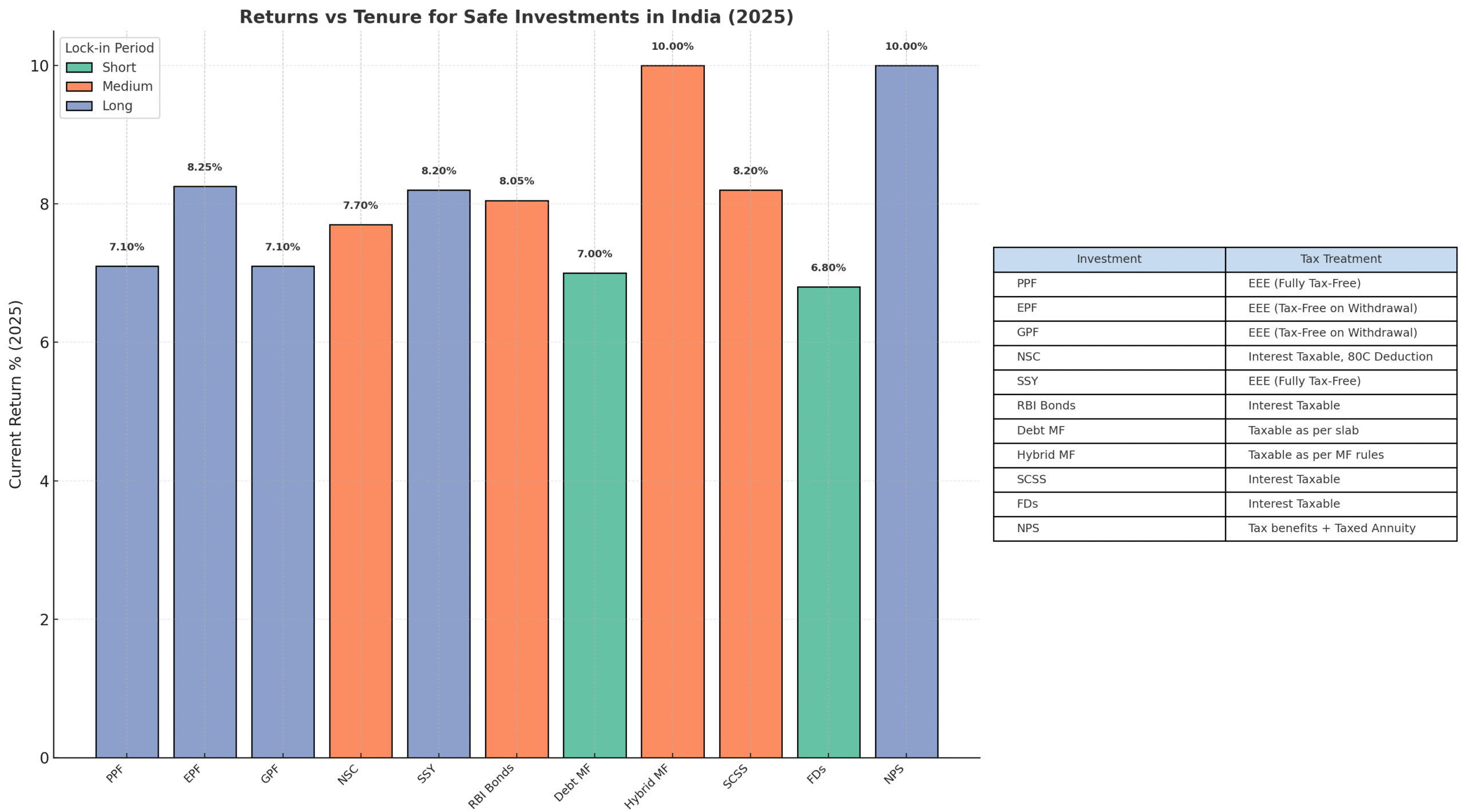
Safe Investment Plan for Teachers (Salary-Wise)
Every teacher’s financial journey is unique. A new graduate teacher in her first job, a mid-career educator balancing school fees and home loans, or a senior principal planning for retirement — each needs a different mix of safe investments in India with high returns. Here’s a salary-wise roadmap to balance safety and growth:
If Salary ≈ ₹30,000/month (New Teacher)
At the start of your career, the priority is safety + habit building.
- PPF: Begin with even ₹2,000–₹5,000/month. At ~7.1% tax-free, it builds a long-term, sovereign-backed safety net.
- Recurring Deposit (RD): Bank RDs (~5–6%) give liquidity for short-term needs while training the discipline of saving.
This stage is about building a safe corpus. Avoid high-risk products. Once your savings habit is set, you’ll be ready to explore better-return options.
If Salary ≈ ₹50,000/month (Mid-Career Teacher)
Now you can balance security with a touch of growth.
- PPF: Continue contributions up to ₹1.5 lakh/year under 80C.
- Hybrid Mutual Fund SIP: Start ₹5,000–₹10,000/month in a balanced/hybrid fund. These funds blend equity (~10% long-term growth) with debt (~6–8%), making them moderate-risk but effective for wealth building.
This mix — PPF + Hybrid SIP — often outperforms FDs, yet remains stable enough to give teachers peace of mind.
If Salary ≈ ₹1,00,000/month (Senior Teacher / Principal)
At this level, diversification is key.
- PPF: Max out contributions (₹1.5 lakh/year).
- NPS: Use the additional ₹50,000 tax benefit (ET Money). Even in a conservative asset mix, NPS has delivered ~9–11% long-term returns.
- Hybrid Fund SIP: Continue for inflation-beating growth.
- RBI Floating Rate Bonds / Debt Funds: Add for steady semi-annual income and safety.
This diversified portfolio — PPF + NPS + Hybrid Fund + RBI Bonds — is one of the best combinations of safe investments in India with high returns. It protects capital, optimizes tax savings, and blends in 8–10% potential returns without exposing you to undue risk.
Teacher’s Lesson: Whether your salary is ₹30k, ₹50k, or ₹1 lakh, the principle remains the same — build your foundation in guaranteed safe instruments, then gradually layer in moderate-risk, higher-return products. That’s how teachers can secure the present and grow for the future.
(Note: These are general plans; individual financial situations may differ. Always align your investments with your personal goals, risk comfort, and family needs.)
Myths Teachers Believe About “Safe Returns”
Finally, let’s clear up a few common myths that often hold back teachers (and others) from optimizing their investments:
Myth 1: “FDs are the safest and best way to save.”
It’s true that bank FDs are very safe, but sticking only to FDs can be a mistake. Why? Standard FD rates (~6–7% today) often barely beat inflation – if at all – and that too before tax. In real terms, money in a 5–6% FD might not grow at all. As one expert cautions, if your money grows less than inflation, its real value actually goes down .
So while FDs are safe, they may not preserve purchasing power, especially after you pay tax on the interest. It’s wise to use FDs for short-term needs or emergency funds, but for long-term goals, some of the alternatives we discussed (PPF, NSC, etc., which are equally safe but offer higher post-tax returns) are better choices.
Myth 2: “Mutual funds = very risky, not for conservative investors.”
The phrase “Mutual funds sahi hai” is common now, but many risk-averse folks still think all mutual funds are like playing the stock market casino. In reality, mutual funds come in many types – not all are high-risk.
- Debt mutual funds largely invest in bonds and can be as stable as FDs (with typical returns of 6–8%, as we saw) .
- Conservative Hybrid funds (75–90% bonds, little equity) are designed for safety-first investors.
So, it’s a myth that any mutual fund is too risky. You can choose funds with low volatility. Yes, equity-heavy funds are volatile in the short term, but products like balanced funds or debt funds are relatively safe (Value Research). Over the long run, a small equity exposure actually helps you beat inflation without taking on excessive risk.
In short, “Mutual funds” is a broad category. As an informed investor, you can pick ones that match your risk appetite. Don’t ignore them completely, or you might miss out on inflation-beating growth.
Myth 3: “Insurance policies are good ‘safe’ investments.”
Many teachers get lured by insurance agents into buying endowment plans or ULIPs, thinking these offer guaranteed returns with insurance – a two-in-one deal. The truth: insurance is not a great investment.
- Traditional life insurance policies (money-back, endowment) often yield only ~5% returns, which barely beat savings accounts.
- Industry data shows insurance companies in India often give just ~5–6% returns on those plans .
- You also lock-in money for long periods with poor liquidity.
The golden rule experts suggest: never mix insurance and investment . If it’s insurance, stick to pure term insurance for protection. If it’s investment, use the avenues we discussed. Don’t fall for the “safe returns” pitch of an insurance-cum-investment plan – you’ll likely get subpar returns and inadequate insurance.
Final Thoughts
For most Indian teachers, the priority is security of money – and rightly so, as it’s hard-earned. The good news is that you don’t have to sacrifice growth for safety. By leveraging government-backed schemes (for a rock-solid foundation) and adding selective low-risk, higher-return investments (to boost overall returns), you can achieve a healthy balance.
In 2025, options like PPF, EPF, NSC, Sukanya Yojana, RBI Bonds and more are offering attractive interest rates that beat inflation while keeping your money safe.
As Mr. Shiv Kumar’s and his colleagues might now realize, “safe investments” no longer mean settling for mediocre growth. With the right mix, a teacher can sleep peacefully knowing their capital is secure and wake up to a portfolio that’s growing robustly. Safe and high returns can go hand-in-hand when you make informed choices. Here’s to smart, safe investing – chalking the path to wealth, one secure step at a time!
Q1. What are the safest investments in India with high returns in 2025?
The top safe investments with high returns in 2025 are:
- PPF – 7.1% (tax-free, sovereign-backed)
- EPF – 8.25% (for salaried employees)
- Sukanya Samriddhi Yojana – 8.2% (EEE tax benefit)
- NSC – 7.7% (5-year lock-in)
- RBI Floating Rate Bonds – 8.05%
All are government-backed, making them secure for teachers and middle-class families.
Q2. What is the current PPF interest rate in 2025, and is it safe?
The PPF interest rate is 7.1% (FY 2025-26). It is one of the safest investments in India with high returns because it is backed by the Government of India and fully tax-free.
Q3. Where to invest money for good return in 2025?
If you want good returns with safety, start with PPF, NSC, SSY, and RBI Bonds. For slightly higher returns, consider a Hybrid Mutual Fund SIP (9–11% long-term) or NPS (9–11%). A mix of these ensures both safety and inflation-beating growth.
Q4. Are Fixed Deposits (FDs) safe and better than inflation in 2025?
Yes, FDs are safe (insured up to ₹5 lakh by DICGC). In 2025, banks are offering 6%–7.5% (up to 8.25% for senior citizens). Since inflation in August 2025 was 1.69%, FDs currently deliver positive real returns — but long-term, they may not beat inflation after tax.
Q5. Which is the safest investment option in India right now?
The safest investments are those backed by the Government of India, such as PPF, SSY, EPF/GPF, NSC, RBI Bonds, and SCSS. These carry sovereign guarantees and almost zero risk. Among them, SSY (8.2%) and EPF (8.25%) are currently giving the highest returns in 2025.
Sources & References
- Moneycontrol – Small Savings & FD Rates
- Economic Times – EPF/GPF Updates
- Value Research – Mutual Fund Analysis
👉 All data updated for 2025. Verified from official or reputed financial platforms.

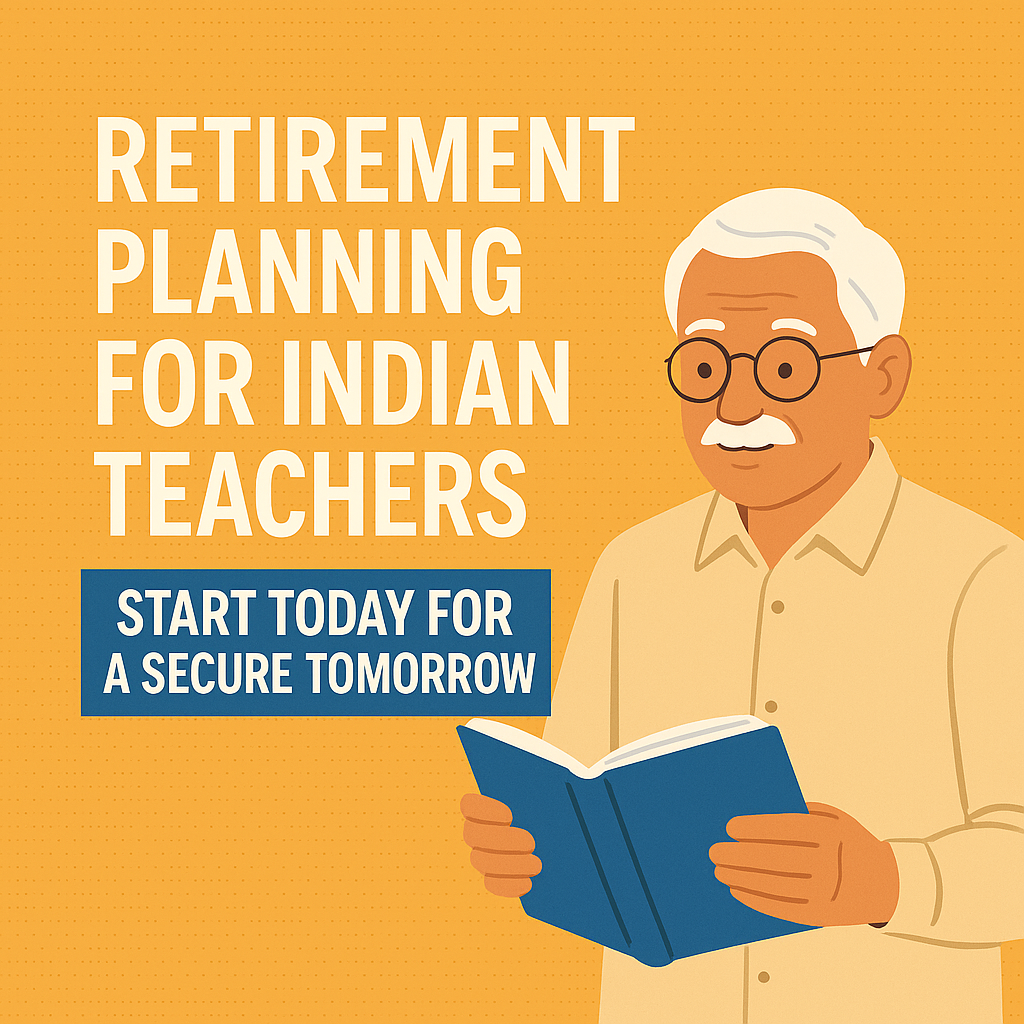
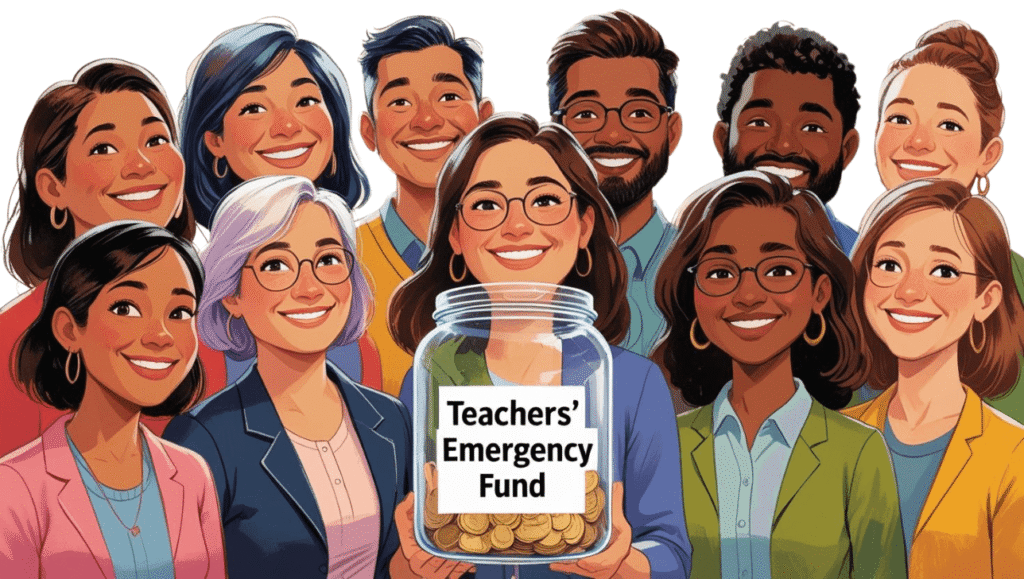
You are doing a great job sir…financial literacy is the need of hour.Everyone should understand this.Some people say that money is not everything but I would rather say that “It’s better to cry in a Mercedes than on a bicycle” .I am really proud that some as a teacher has taken up this genuine subject for teaching the whole society.Sometimes I really think that it’s an irony that our life hovers around money till death but still we don’t pay respect and importance to money which it deserve.Once again a great job sir from your side.God bless u.
Thank you so much, Rajan Sir, for your encouraging words 🙏.
You are absolutely right—financial literacy is the real need of the hour. We spend our entire lives around money, yet often don’t give it the respect it deserves. At Chalk2Wealth, my small effort is to make teachers, parents, and families more confident in managing their hard-earned money.
Money isn’t everything, but as you beautifully said, it surely gives us security, dignity, and choices in life. I’m grateful for your support. Do keep sharing your thoughts and also suggest topics you’d like me to cover—your feedback will help me serve our teaching community better.